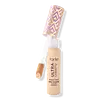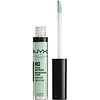What's inside
What's inside
 Key Ingredients
Key Ingredients

 Benefits
Benefits

 Concerns
Concerns

 Ingredients Side-by-side
Ingredients Side-by-side

Water
Skin ConditioningCyclopentasiloxane
EmollientGlycerin
HumectantPolymethylsilsesquioxane
PEG-9 Polydimethylsiloxyethyl Dimethicone
EmulsifyingCaprylic/Capric Triglyceride
MaskingCaprylyl Methicone
Skin ConditioningC13-15 Alkane
SolventSorbitan Isostearate
EmulsifyingDimethicone
EmollientPhenyl Trimethicone
Skin ConditioningAcrylates/Stearyl Acrylate/Dimethicone Methacrylate Copolymer
Hydroxyethyl Urea
HumectantMagnesium Sulfate
Aluminum Hydroxide
EmollientIsotridecyl Isononanoate
EmollientTriethyl Citrate
MaskingCetyl PEG/PPG-10/1 Dimethicone
EmulsifyingPolypropylsilsesquioxane
Dimethicone Crosspolymer
Emulsion StabilisingQuaternium-90 Bentonite
Triethoxycaprylylsilane
Sodium Benzoate
MaskingParfum
MaskingDisteardimonium Hectorite
StabilisingPotassium Sorbate
PreservativePolyhydroxystearic Acid
EmulsifyingPropylene Carbonate
SolventEthylhexyl Palmitate
EmollientIsopropyl Myristate
EmollientIsostearic Acid
CleansingLecithin
EmollientPropanediol
SolventDisodium EDTA
Polyglyceryl-3 Polyricinoleate
EmulsifyingBenzyl Salicylate
PerfumingHexyl Cinnamal
PerfumingLimonene
PerfumingOpuntia Ficus-Indica Stem Extract
Skin ConditioningHydroxycitronellal
PerfumingGeraniol
PerfumingMaltodextrin
AbsorbentAmyl Cinnamal
PerfumingLinalool
PerfumingButylene Glycol
HumectantSodium Hyaluronate Crosspolymer
HumectantCitric Acid
BufferingSpiraea Ulmaria Extract
Astringent1,2-Hexanediol
Skin ConditioningHydrolyzed Glycosaminoglycans
HumectantSodium Hyaluronate
HumectantAloe Barbadensis Leaf Extract
EmollientButyrospermum Parkii Butter
Skin ConditioningGlycyrrhiza Glabra Root Extract
BleachingOlea Europaea Fruit Oil
MaskingPersea Gratissima Oil
Skin ConditioningSqualane
EmollientUlmus Davidiana Root Extract
Skin ConditioningMangifera Indica Seed Butter
Skin ConditioningHelianthus Annuus Seed Oil
EmollientBenzyl Glycol
SolventPanax Ginseng Root Extract
EmollientHydrolyzed Hyaluronic Acid
HumectantPentaerythrityl Tetra-Di-T-Butyl Hydroxyhydrocinnamate
AntioxidantEthylhexylglycerin
Skin ConditioningPhenoxyethanol
PreservativeHyaluronic Acid
HumectantConvallaria Majalis Bulb/Root Extract
Skin ConditioningLeontopodium Alpinum Flower/Leaf Extract
Skin ConditioningLilium Candidum Flower Extract
Skin ConditioningMagnolia Liliflora Flower Extract
Skin ConditioningPaeonia Lactiflora Root Extract
Skin ConditioningRaspberry Ketone
MaskingTocopherol
AntioxidantTbhq
AntioxidantTitanium Dioxide
Cosmetic ColorantIron Oxides
Water, Cyclopentasiloxane, Glycerin, Polymethylsilsesquioxane, PEG-9 Polydimethylsiloxyethyl Dimethicone, Caprylic/Capric Triglyceride, Caprylyl Methicone, C13-15 Alkane, Sorbitan Isostearate, Dimethicone, Phenyl Trimethicone, Acrylates/Stearyl Acrylate/Dimethicone Methacrylate Copolymer, Hydroxyethyl Urea, Magnesium Sulfate, Aluminum Hydroxide, Isotridecyl Isononanoate, Triethyl Citrate, Cetyl PEG/PPG-10/1 Dimethicone, Polypropylsilsesquioxane, Dimethicone Crosspolymer, Quaternium-90 Bentonite, Triethoxycaprylylsilane, Sodium Benzoate, Parfum, Disteardimonium Hectorite, Potassium Sorbate, Polyhydroxystearic Acid, Propylene Carbonate, Ethylhexyl Palmitate, Isopropyl Myristate, Isostearic Acid, Lecithin, Propanediol, Disodium EDTA, Polyglyceryl-3 Polyricinoleate, Benzyl Salicylate, Hexyl Cinnamal, Limonene, Opuntia Ficus-Indica Stem Extract, Hydroxycitronellal, Geraniol, Maltodextrin, Amyl Cinnamal, Linalool, Butylene Glycol, Sodium Hyaluronate Crosspolymer, Citric Acid, Spiraea Ulmaria Extract, 1,2-Hexanediol, Hydrolyzed Glycosaminoglycans, Sodium Hyaluronate, Aloe Barbadensis Leaf Extract, Butyrospermum Parkii Butter, Glycyrrhiza Glabra Root Extract, Olea Europaea Fruit Oil, Persea Gratissima Oil, Squalane, Ulmus Davidiana Root Extract, Mangifera Indica Seed Butter, Helianthus Annuus Seed Oil, Benzyl Glycol, Panax Ginseng Root Extract, Hydrolyzed Hyaluronic Acid, Pentaerythrityl Tetra-Di-T-Butyl Hydroxyhydrocinnamate, Ethylhexylglycerin, Phenoxyethanol, Hyaluronic Acid, Convallaria Majalis Bulb/Root Extract, Leontopodium Alpinum Flower/Leaf Extract, Lilium Candidum Flower Extract, Magnolia Liliflora Flower Extract, Paeonia Lactiflora Root Extract, Raspberry Ketone, Tocopherol, Tbhq, Titanium Dioxide, Iron Oxides
Water
Skin ConditioningTrimethylsiloxyphenyl Dimethicone
Trimethylsiloxysilicate
EmollientGlycerin
HumectantSilica
AbrasiveIsononyl Isononanoate
EmollientSorbitan Olivate
EmulsifyingCaprylic/Capric Triglyceride
MaskingCocos Nucifera Oil
MaskingAloe Barbadensis Leaf Extract
EmollientTocopheryl Acetate
AntioxidantTriethoxycaprylylsilane
Euphorbia Cerifera Wax
Xanthan Gum
EmulsifyingAlumina
AbrasiveCaprylyl Glycol
EmollientPhenoxyethanol
PreservativeTitanium Dioxide
Cosmetic ColorantIron Oxides
CI 77742
Cosmetic ColorantCI 77007
Cosmetic ColorantCI 77289
Cosmetic ColorantCI 77288
Cosmetic ColorantCI 19140
Cosmetic ColorantWater, Trimethylsiloxyphenyl Dimethicone, Trimethylsiloxysilicate, Glycerin, Silica, Isononyl Isononanoate, Sorbitan Olivate, Caprylic/Capric Triglyceride, Cocos Nucifera Oil, Aloe Barbadensis Leaf Extract, Tocopheryl Acetate, Triethoxycaprylylsilane, Euphorbia Cerifera Wax, Xanthan Gum, Alumina, Caprylyl Glycol, Phenoxyethanol, Titanium Dioxide, Iron Oxides, CI 77742, CI 77007, CI 77289, CI 77288, CI 19140
 Reviews
Reviews

Ingredients Explained
These ingredients are found in both products.
Ingredients higher up in an ingredient list are typically present in a larger amount.
Aloe Barbadensis Leaf Extract is an extract of the leaves of the aloe, Aloe barbadensis, Liliaceae.
Aloe is one of the most well-known natural soothing ingredients, and for good reason. It’s full of water and has a cooling, calming effect on the skin, especially when it’s sunburned, itchy, or irritated. Aloe also helps your skin stay hydrated and smooth by mimicking what healthy skin naturally produces. On top of that, it contains vitamins and nutrients that support skin recovery.
It doesn’t protect you from the sun, but it can help your skin bounce back after too much time in it.
Let’s get into the details:
Aloe contains antioxidant Vitamins A, C, and E, which help fight off free radicals (unstable molecules from things like pollution that can damage your skin).
It’s also rich in polysaccharides, which are natural sugars that help hydrate the skin by acting like the skin’s own moisturizing agents. These, along with other sugars like monosaccharides, help form a protective barrier that locks in moisture.
Aloe works as both a humectant and an emollient. That means it draws water into the skin (humectant) and helps trap it there (emollient), making it an effective natural moisturizer.
You’ll also find a mix of other skin-supporting ingredients in aloe, including folic acid, choline, calcium, amino acids, fatty acids, and even Vitamin B12.
Out of the 420+ species of aloe, Aloe barbadensis is the most widely used in skincare products thanks to its gentle yet effective properties.
There are over 420 species of aloe but Aloe Barbadensis is the most commonly used for topical products.
Learn more about Aloe Barbadensis Leaf ExtractThis ingredient is an emollient, solvent, and texture enhancer. It is considered a skin-softener by helping the skin prevent moisture loss.
It helps thicken a product's formula and makes it easier to spread by dissolving clumping compounds.
Caprylic Triglyceride is made by combining glycerin with coconut oil, forming a clear liquid.
While there is an assumption Caprylic Triglyceride can clog pores due to it being derived from coconut oil, there is no research supporting this.
Learn more about Caprylic/Capric TriglycerideGlycerin is already naturally found in your skin. It helps moisturize and protect your skin.
A study from 2016 found glycerin to be more effective as a humectant than AHAs and hyaluronic acid.
As a humectant, it helps the skin stay hydrated by pulling moisture to your skin. The low molecular weight of glycerin allows it to pull moisture into the deeper layers of your skin.
Hydrated skin improves your skin barrier; Your skin barrier helps protect against irritants and bacteria.
Glycerin has also been found to have antimicrobial and antiviral properties. Due to these properties, glycerin is often used in wound and burn treatments.
In cosmetics, glycerin is usually derived from plants such as soybean or palm. However, it can also be sourced from animals, such as tallow or animal fat.
This ingredient is organic, colorless, odorless, and non-toxic.
Glycerin is the name for this ingredient in American English. British English uses Glycerol/Glycerine.
Learn more about GlycerinPhenoxyethanol is a preservative that has germicide, antimicrobial, and aromatic properties. Studies show that phenoxyethanol can prevent microbial growth. By itself, it has a scent that is similar to that of a rose.
It's often used in formulations along with Caprylyl Glycol to preserve the shelf life of products.
Titanium dioxide is a mineral UV filter widely used in sunscreens and cosmetics.
It is one of only two UV filters officially classified as “mineral” by regulatory agencies, the other being zinc oxide.
Titanium dioxide provides broad-spectrum protection mostly in the UVB and UVAII range, with some protection in the UVAI range.
While its UVA protection isn’t as strong as zinc oxide’s, the difference is minor.
A common myth is that mineral UV filters reflect UV light. However, modern research shows titanium dioxide absorbs UV radiation like chemical filters (~95% absorption & 5% reflection).
Thanks to its non-irritating nature, titanium dioxide is suitable for sensitive, acne-prone, or redness-prone skin. It is unlikely to cause "eye sting" like other sunscreen ingredients.
A major drawback of this ingredient is its white cast and thick texture. This is why mineral sunscreens often leave a white cast and are less cosmetically elegant than chemical/hybrid sunscreens.
To improve white cast and spreadability, micronized or nano-sized titanium dioxide is often used.
There are ongoing concerns surrounding nano-titanium oxide's impact on marine ecosystems.
There is no conclusive evidence that any form of titanium oxide (or any other sunscreen ingredients) will cause harm to marine ecosystems or coral reefs. The science is still developing but many consumers are keeping a close eye on this issue.
Please note, many destinations have reef-safety sunscreen rules. For instance, the U.S. Virgin Islands advises all visitors to use non-nano mineral sunscreens.
Nano mineral sunscreens once raised safety concerns about absorption into skin.
Extensive research has shown that they do not penetrate healthy or damaged skin; they remain safely on the surface and the top layer of dead skin (stratum corneum).
You'll likely find titanium dioxide bundled with alumina, silica, or dimethicone. These ingredients help make titanium dioxide highly photostable; this prevents it from interacting with other formula components under UV light.
Learn more about Titanium DioxideTriethoxycaprylylsilane is a silicone used to bind and stabilize ingredients.
As an emulsifier, it helps prevent ingredients from separating. This can help elongate the shelf life of products.
Triethoxycaprylylsilane is often used to coat mineral sunscreens ingredients to help give a better feel. It also helps reduce oxidative stress in sunscreens.
Learn more about TriethoxycaprylylsilaneWater. It's the most common cosmetic ingredient of all. You'll usually see it at the top of ingredient lists, meaning that it makes up the largest part of the product.
So why is it so popular? Water most often acts as a solvent - this means that it helps dissolve other ingredients into the formulation.
You'll also recognize water as that liquid we all need to stay alive. If you see this, drink a glass of water. Stay hydrated!
Learn more about WaterThis ingredient is a combination of red, black, and yellow iron oxide pigments. This combination of colors is usually found in foundation, because it results in a "skin" color.